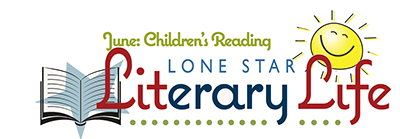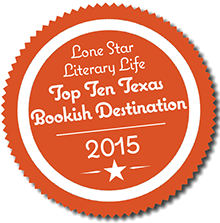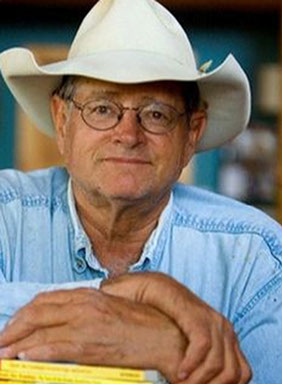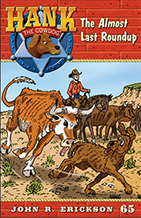
Connecting Texas books and writers with those who most want to discover them


TRAVELING?
Don't miss our
Top Bookish
Destinations
Lone Star Listens
Author interviews by
Kay Ellington, LSLL Publisher
 Kay Ellington has worked in management for a variety of media companies including Gannett, Cox Communications, Knight-Ridder, and the New York Times Regional Group, from Texas to New York to California to the Southeast and back again to Texas. She is the coauthor, with Barbara Brannon, of the West Texas novel The Paragraph Ranch.
Kay Ellington has worked in management for a variety of media companies including Gannett, Cox Communications, Knight-Ridder, and the New York Times Regional Group, from Texas to New York to California to the Southeast and back again to Texas. She is the coauthor, with Barbara Brannon, of the West Texas novel The Paragraph Ranch.
John R. Erickson has written and published 75 books and more than 600 articles and is best known as the author of the Hank the Cowdog series of books, audiobooks, and stage plays.
His stories have won a number of awards, including the Audie, Oppenheimer, Wrangler, and Lamplighter Awards and have been translated into Spanish, Danish, Farsi, and Chinese.
The Hank the Cowdog series began as a self-publishing venture in his garage in 1982 and has endured to become one of the nation’s most popular series for children and families. Through the eyes of Hank the Cowdog, a smelly, smart-aleck Head of Ranch Security, Erickson gives readers a glimpse of daily life on a ranch in the West Texas Panhandle. USA Today calls the series "the best family entertainment in years.”
John Richard Erickson was born in Midland, Texas, on October 20, 1943, to Joseph W. Erickson and Anna Beth Curry Erickson, the youngest of three children. In 1946, the family moved to Perryton, Texas, in the northeastern Texas Panhandle. . .
John started first grade in the Perryton school system and graduated from high school in the class of 1962. His talent for writing went unnoticed until his senior year in high school, when his English teacher, Annie Love, made the class write an original poem. Erickson found that it was easy for him. For the rest of the year, he stayed up late at night, writing poems for Mrs. Love.
Erickson attended the University of Denver for a year, then finished his B.A. degree at the University of Texas in Austin. For two years, he studied theology at Harvard Divinity School and left three hours short of a master’s degree. At UT he met his future wife, Kristine Dykema, and they were married in Dallas in 1967.
From the start, Erickson intended for the Hank stories to be read aloud, and one of the unique features of the series is that he has recorded all stories in the audiobook format, performing all the character voices himself and composing two original songs for each episode.
Publishers Weekly calls the Hank the Cowdog series a "grassroots publishing phenomenon,” and, to date, the series has sold over 8 million copies. For more than thirty years, Erickson has worked hard to maintain the highest standards of good, wholesome family entertainment. In doing that, he has built a bond of trust with parents, librarians, and teachers, and all his stories have been approved for the Accelerated Reader Program. He has appeared in thousands of schools, from Fairbanks, Alaska, to Key West, Florida, and has been a popular speaker at conventions of teachers, librarians, and homeschoolers.
Erickson is currently working with a film group to produce a Hank the Cowdog animated movie, with the screenplay written by John and his son Mark. The movie is expected to reach theaters in 2015.
John and Kris live on their cattle ranch near Perryton, Texas, and stay in touch with the world through the Official Hank Website www.hankthecowdog.com. They have three grown children and four grandchildren.
Extracted from www.hankthecowdog.com)
 6.14.2015
6.14.2015
John R. Erickson on the discipline of writing, the world of publishing, and (of course) dogs
John R. Erickson has provided life lessons and laughter for a generation of Texas children—and adults— through the antics and insights of his character Hank the Cowdog. Erickson’s long-running series of children's books (illustrated by Gerald L. Holmes) follows canine Hank, self-appointed "Head of Ranch Security." In each book Hank and other characters must deal with events, issues, and mysteries that occur at their Texas Panhandle home, the M-Cross Ranch. Hank, and his pals have been a part of the life of Texas schoolchildren for more than four decades.
Months ago, when we were planning our editorial calendar for the year, we knew there was one author that we hoped to interview for our children’s literature special section in the summer. But we tried to think how to convey the wit that Erickson has always displayed in Hank’s musings, book after book. We finally came up with the idea to “interview Hank.” Erickson was a good sport, and Hank “told all” here in last week’s issue via an email interview.
This week, John Erickson graciously agreed to be interviewed by email as well.
LONE STAR LITERARY LIFE: John, when did you know you wanted to be a writer?
JOHN R. ERICKSON: I didn’t do any writing until I was a senior in high school, when I discovered that I could write poetry. In college, I did well in courses that required essays and during my second year at Harvard Divinity School, I took a fiction writing course in the Yard. I was married then and started writing every day. Kris brought discipline and meaning into my life. So I guess the answer is that in 1967, I started thinking seriously about being a writer, even though I knew it wasn’t an easy thing to do.
You were a pioneer in self-publishing. What made you read the tea leaves and decide you could launch your own publishing company?
I wasn’t exactly reading tea leaves. I wanted to follow the Hemingway model: find a New York publisher, get a big advance, go to cocktail parties, and be a famous author. That didn’t work out. For fifteen years I wrote four hours a day and sent out manuscripts. I attended writers’ conferences and talked to editors. Nothing worked. Either I didn’t know what the editors were looking for, or I knew didn’t want to do it.
When Kris and I started Maverick Books in 1982, it was an act of desperation. We had to try something different or quit. We felt there were other people in our region who were tired of bleak, depressing books that someone called “great literature.” And we were foolish enough to think that we could succeed with our own publishing company—in a town that didn’t even have a bookstore.
I guess we’ve done pretty well. The Hank series has sold more than 8.5 million copies, and we control all the movie and subsidiary rights.
How did you and your long-time illustrator, Gerald L. Holmes, come to work together?
I met Gerald through a mutual friend, photographer Bill Ellzey, in 1977. I was working as a cowboy in Oklahoma and Gerald worked in a feedlot near Perryton. We were both as poor as snowbirds. He showed me some of his pen and ink drawings, and I knew I wanted to work with him. He grew up on a ranch near Waurika, Oklahoma, and he sure knew how to put expression on the face of a dog or cowboy. He started illustrating some of my magazine articles, then when I wrote the first Hank book, he was my first choice as illustrator. We’ve worked together on the Hank books for thirty-three years, and he has never missed a deadline.
How has publishing changed since you started?
In 1982, the main problems were getting something out in front of the public and then figuring out how to sell it. Today, it is much easier to solve the mechanical problems of self-publishing and to reach an audience, but the fact that it’s easier creates another problem: how can you be heard above all the noise? The mass of information that is available today, through film, television, books, magazines, newspapers, and the Internet is really intimidating.
And, of course, the problem of selling your work remains, making a living with your writing. It may even be more difficult today because so much of Internet content is free. Newspapers, magazines, publishers, and book sellers are facing unique and difficult times, and so are the writers who have depended on them as a source of income. Google and Facebook are getting fabulously rich, selling ads. Writers are pecking for seeds.
You and your wife have three children. Are any of them writers or involved in your publishing ventures?
We encouraged our children (Scot, Ashley, and Mark) to write good letters and grammatical English, but never pushed for anything beyond that. Mark has bloomed into an excellent writer, and for several years we have been working together on movie and television scripts for the Hank material. It’s helpful that he also has a law degree.
What is your current writing process like?
My writing process hasn’t changed much since 1967. I get up early, usually around 5:30, and walk to my office, which has always been separated from the house. I’ve written in a barn, a garage, a bunkhouse, and a tool shed. Now I have a small but fairly nice office that is walking distance from our home.
I write for no more than four and a half hours. For me, that’s a day’s work. Writing is an intense discipline, and after four and a half hours, I’m mentally tired. I spend the rest of the day doing physical work on our ranch, answering mail, and reading. For me, it has always been important to balance writing with physical work that is connected to something real: earth, grass, sweat, animals, and family.
What advice would you have for aspiring authors?
When I speak to writers, I often advise them to marry for money. That is a funny way of saying that artistic people (artists, actors, musicians, and writers) are always faced with the problem of how to make a living from their work. We spend all our time learning a craft, and most of us are short on business skills.
I get a lot of letters and emails from young and aspiring writers, and several years ago I took the time to write a book that tells about my experiences and gives my best advice to young writers. It’s called Story Craft. Here are some of the points I made in the book.
• The first ingredient in good writing is content, not style. Write what you know and love, and use sentences that you can diagram.
• Discipline yourself to write every day, even if it’s just for thirty minutes. Writers write. They don’t talk about it in a bar, take courses, or read books. They develop professional habits and learn to write by writing.
• Seek beauty and order in human experience, and nourish the human soul with your writing. If art can’t make people better, wiser, or happier, what’s the point?
• Have a marketable skill that can sustain you while you’re learning the craft of writing. I worked as a cowboy, bartender, and handyman for fifteen years.
• Don’t write anything that would shame your mother. I know that sounds corny, but it’s a simple way of saying that we belong to a larger community and tradition. Writing involves more than your freedom to say anything that comes to your mind. Our writing ought to make the reader better than he was before. That’s a piece of wisdom mothers understand by instinct, and entertainment companies sometimes ignore.
Which Texas authors did you read growing up? Which Texas authors do you enjoy reading now?
I didn’t enjoy reading when I was young. I was soaked in the King James Bible and loved Mark Twain, but spent most of my youth climbing trees, playing outside, and working on ranches. I didn’t discover Texas writers until I had lived in cities for eight years and returned to Texas.
At that point, I made a serious effort to catch up: J. Frank Dobie, J. Evetts Haley, Larry King, Owen White, Ben Green, Al Dewlen, A. C. Greene, and a number of others. I read Larry McMurty’s early novels and his book of essays.
The two Texas authors who influenced me most were Elmer Kelton and John Graves. Both were “regional” authors who were deeply attached to a place. They wrote exceptionally well and found an audience beyond their region. I was a friend to both and corresponded with them over the years.
Today, I don’t read many Texas authors, although I admire the work of S. J. Dahlstrom and Christian Wiman, both from West Texas.
I’ve always been a slow reader and I’m always behind. I don’t consider myself well-read in any subject. My reading is eccentric and follows my curiosity, which recently has included English philosopher Roger Scruton, theologian Nancy Pearcey, physicist Paul Davies, ex–CIA agent Robert Baer, and a biography of J. S. Bach. I have a long-standing fascination with ancient Egypt, classical music, range management, quantum physics, and archeology in the Texas Panhandle. It’s an odd mix.
You do the voiceover for all of the Hank the Cowdog audio books. Would you recommend that process to other authors?
Not necessarily. From the start, the prose in my Hank books copied the storytelling techniques of ranchers and cowboys, which means it was heavily influenced by an oral tradition. It was a natural and easy step to move from reading my stories aloud to audiences in Perryton, to recording them in a studio in Amarillo. The Hank audios have the feel of the radio programs I listened to in the fifties: character voices, background music, and sound effects.
I had no training or certificate that said I was qualified to do it. I’ve never taken an acting course and consider myself an amateur, even though I’ve been doing it for thirty-three years. I got the job because I work cheap and make deadlines. It’s the kind of thing you can do when you’re paying the bills and nobody in a lofty position is saying, “You can’t do that.”
Stories that were not meant to be read aloud might not adapt well to the audio medium. I love the work of C. S. Lewis, but the audiobook versions of his stories leave me comatose. I think it’s best to meet Lewis, and probably a lot of other writers, through the printed word.
Last question: What continues to inspire you to write after 65 Hank books?
I don’t think in terms of inspiration. I go to my office every morning, whether I’m inspired or not, and pull my plow like a mule. For me, the discipline takes the place of inspiration. Some days, it’s great fun. Some days it’s not.
Once I get rolling with a Hank book, I’m having a grand old time. I laugh out loud and am anxious to get back to it the next morning. I am endlessly fascinated by Hank’s character, and I suppose by dogs in general—the extraordinary relationship that has bound dogs and humans together for at least ten thousand years. As I once wrote, “Only the Maker of galaxies would have thought to give mankind such a marvelous gift as a dog.”
* * * * *

Hank the Cowdog: The Almost Last Roundup
Book #65 in the Hank the Cowdog series
John R. Erickson; illustrated by Gerald L. Holmes
March 2015
144 pages; 13 B/W illustrations. Bonus activities in back of book.
Hardcover, 978-1-59188-265-7, $15.99
Paperback, 978-1-59188-165-0, $5.99
Audiobook (CDs), 978-1-59188-665-5, $19.99
Ebook version also available
About the book
Hank the Cowdog has seen dry summers in his years as the Head of Ranch Security, but nobody on the ranch has seen a drought like this. Ponds have dried up, the creek is down to a trickle, pastures have turned to burned toast, and the cows are kicking up clouds of dust.
Then, to top it all off, Pete the Barncat hatches a dastardly plot to ruin Loper’s birthday! The last thing the cowboys need is a prairie fire, but that’s what they get, and it begins to look like the next roundup might be their last. What the ranch really needs is a good rain to bring back the grass . . . and Loper’s good mood!
![]()
![]() LONE STAR LITERARY LIFE copyright © 2015–18 Paragraph Ranch LLC • All rights reserved • CONTACT US
LONE STAR LITERARY LIFE copyright © 2015–18 Paragraph Ranch LLC • All rights reserved • CONTACT US

